
Mare Nectaris is a small lunar mare or sea located south of Mare Tranquillitatis southwest of Mare Fecunditatis, on the near side of the Moon. Montes Pyrenaeus borders the mare to the east and Sinus Asperitatis fuses to its northwestern edge. It is 84,000 square kilometers in size.
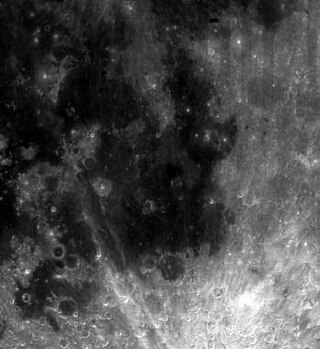
Mare Nubium is a lunar mare in the Nubium basin on the Moon's near side. The mare is located just to the southeast of Oceanus Procellarum.

The lunar geological timescale divides the history of Earth's Moon into five generally recognized periods: the Copernican, Eratosthenian, Imbrian, Nectarian, and Pre-Nectarian. The boundaries of this time scale are related to large impact events that have modified the lunar surface, changes in crater formation through time, and the size-frequency distribution of craters superposed on geological units. The absolute ages for these periods have been constrained by radiometric dating of samples obtained from the lunar surface. However, there is still much debate concerning the ages of certain key events, because correlating lunar regolith samples with geological units on the Moon is difficult, and most lunar radiometric ages have been highly affected by an intense history of bombardment.

The Copernican Period in the lunar geologic timescale runs from approximately 1.1 billion years ago to the present day. The base of the Copernican period is defined by impact craters that possess bright optically immature ray systems. The crater Copernicus is a prominent example of rayed crater, but it does not mark the base of the Copernican period.
The Nectarian Period of the lunar geologic timescale runs from 3920 million years ago to 3850 million years ago. It is the period during which the Nectaris Basin and other major basins were formed by large impact events. Ejecta from Nectaris form the upper part of the densely cratered terrain found in lunar highlands.
The pre-Nectarian period of the lunar geologic timescale runs from 4.533 billion years ago to 3.920 billion years ago, when the Nectaris Basin was formed by a large impact. It is followed by the Nectarian period.

Eratosthenes crater is a relatively deep lunar impact crater that lies on the boundary between the Mare Imbrium and Sinus Aestuum mare regions. It forms the western terminus of the Montes Apenninus mountain range. It is named after ancient Greek astronomer Eratosthenes of Cyrene, who estimated the circumference of the Earth, and the distance from the Earth to the Sun.

Fabricius is a lunar impact crater that is located within the northeast part of the walled plain Janssen. Attached to the north-northwest rim is the slightly larger crater Metius. Fabricius has multiple central peaks that rise to 0.8 km, with a rugged rise to the northwest running north–south. The rim is lumpy and somewhat distended, most noticeably to the southwest and south. It is 78 kilometers in diameter and 2,500 meters deep. It is from the Eratosthenian period, 3.2 to 1.1 billion years ago. It is named after David Fabricius, a 16th-century German astronomer.
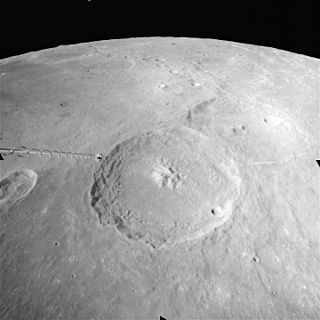
Theophilus is a prominent lunar impact crater that lies between Sinus Asperitatis in the north and Mare Nectaris to the southeast. It partially intrudes into the comparably sized crater Cyrillus to the southwest. To the east is the smaller crater Mädler and further to the south-southeast is Beaumont. It was named after the 4th-century Coptic Pope Theophilus I of Alexandria.
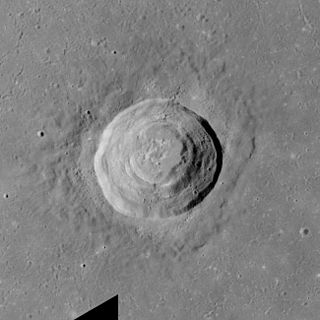
Picard is a lunar impact crater that lies in Mare Crisium. The crater is named for 17th century French astronomer and geodesist Jean Picard. It is the biggest non-flooded crater of this mare, being slightly larger than Peirce to the north-northwest. To the west is the almost completely flooded crater Yerkes. To east of Picard is the tiny Curtis.

Agrippa is a lunar impact crater that is located at the southeast edge of the Mare Vaporum. It is located to the north of the crater Godin, the irregular Tempel lies just to the east. To the north and northeast, the rille designated Rima Ariadaeus follows a course to the east-southeast, reaching the western edge of Mare Tranquillitatis. It is named after the 1st century Greek astronomer Agrippa.

Theon Junior is a lunar impact crater that is located just to the west-southwest of the crater Delambre. It forms a matching pair with Theon Senior, only a couple of crater diameters to the north-northwest. The crater is circular and bowl-shaped, with a small floor at the bottom of the high, sloping interior walls. It is named for Theon of Alexandria, a 4th-century Greek astronomer and mathematician. The crater is from the Eratosthenian period, which lasted from 3.2 to 1.1 billion years ago. It is 17 kilometers in diameter and the difference in height at its rim and its deepest part is 3,580 meters.

Theon Senior is a lunar impact crater that is located to the northwest of the crater Delambre, and south of D'Arrest. It forms a matching pair with Theon Junior, about two crater diameters to the south-southeast. The satellite crater Theon Senior A can be found to the north. Theon Senior is named for Theon of Smyrna, a 1st-2nd century Greek mathematician and philosopher.
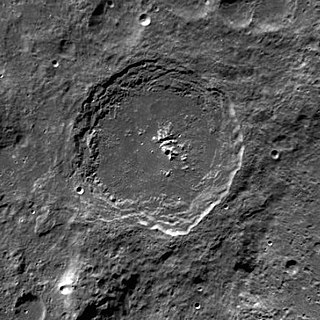
Hausen is a large lunar impact crater that lies along the south-southwestern limb of the Moon. It was named after German astronomer Christian A. Hausen by the IAU in 1961.
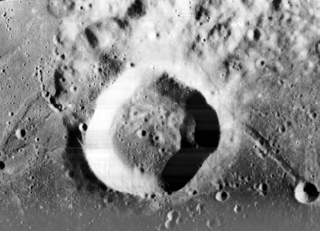
Lunar craters are impact craters on Earth's Moon. The Moon's surface has many craters, all of which were formed by impacts. The International Astronomical Union currently recognizes 9,137 craters, of which 1,675 have been dated.
The Cryptic era is an informal term for the earliest geologic evolution of the Earth and Moon. It is the oldest (informal) era of the Hadean eon, and it is commonly accepted to have begun close to about 4.533 billion years ago when the Earth and Moon formed, and lasted to about 4.15 billion years ago. No samples exist to date the transition between the Cryptic era and the following Basin Groups era for the Moon, though sometimes it is stated that this era ended 4150 million years ago for one or both of these bodies. Neither this time period, nor any other Hadean subdivision, has been officially recognized by the International Commission on Stratigraphy.

The geology of the Moon is quite different from that of Earth. The Moon lacks a true atmosphere, and the absence of free oxygen and water eliminates erosion due to weather. Instead, the surface is eroded much more slowly through the bombardment of the lunar surface by micrometeorites. It does not have any known form of plate tectonics, it has a lower gravity, and because of its small size, it cooled faster. In addition to impacts, the geomorphology of the lunar surface has been shaped by volcanism, which is now thought to have ended less than 50 million years ago. The Moon is a differentiated body, with a crust, mantle, and core.
Basin Groups refers to 9 subdivisions of the lunar Pre-Nectarian geologic period. It is the second era of the Hadean.
The Imbrian is a lunar geologic period divided into two epochs, the Early and Late.

Volcanism on the Moon is represented by the presence of volcanoes, pyroclastic deposits and vast lava plains on the lunar surface. The volcanoes are typically in the form of small domes and cones that form large volcanic complexes and isolated edifices. Calderas, large-scale collapse features generally formed late in a volcanic eruptive episode, are exceptionally rare on the Moon. Lunar pyroclastic deposits are the result of lava fountain eruptions from volatile-laden basaltic magmas rapidly ascending from deep mantle sources and erupting as a spray of magma, forming tiny glass beads. However, pyroclastic deposits formed by less common non-basaltic explosive eruptions are also thought to exist on the Moon. Lunar lava plains cover large swaths of the Moon's surface and consist mainly of voluminous basaltic flows. They contain a number of volcanic features related to the cooling of lava, including lava tubes, rilles and wrinkle ridges.




















